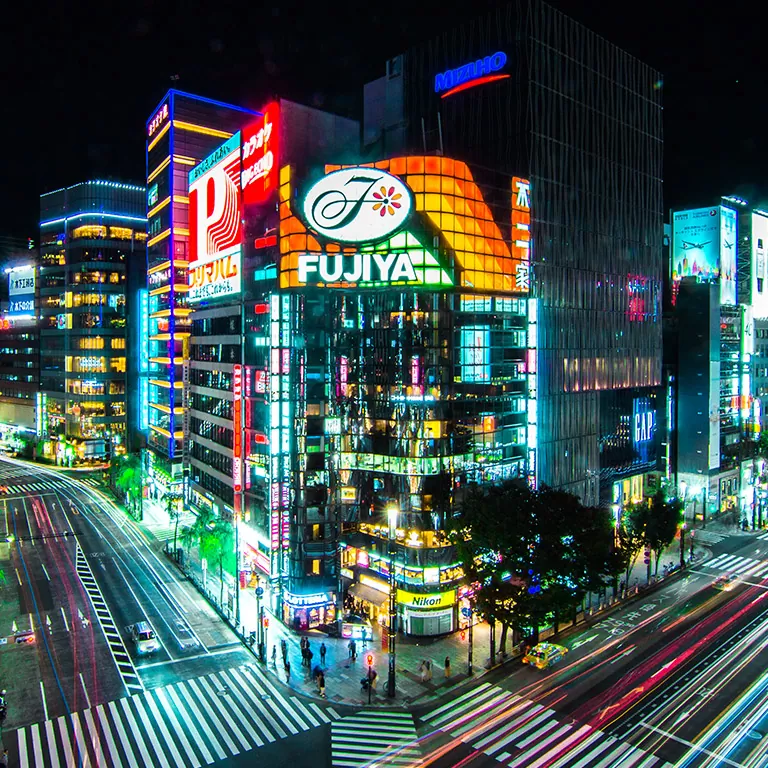
Make no mistake about the 9.7 million inhabitants registered in Tokyo, about half of Rio de Janeiro’s population. This is because Japan’s capital has the most densely populated urban area on the planet – if we consider the Metropolitan Region – with 37 million people illuminated by the place that also boasts another title: the highest concentration of neon lights in the world, as easy to see as the volume of people in its streets. The glow of neon is reminiscent of fire, and also of a Phoenix that rose from ashes, just like Tokyo, devastated twice and twice rebuilt, each time more imposingly.
The first time, in 1923, the capital of the Japanese Empire was seriously impacted by a devastating earthquake. A little over 20 years later, the destruction came, not from the ground, but from the air, from American bombing during World War II. About 51% of Tokyo’s area was destroyed, together with the families of 150 thousand people killed in the attacks and 260 thousand buildings. With the Japanese instrument of surrender and demilitarization, came the investment in education, technology and infrastructure that elevated Japan to the condition of first-world country, according to the World Bank and the International Monetary Fund.
Though created by Greek mythology, the Phoenix became more Japanese than ever when making Tokyo the financial, political, commercial, educational and cultural capital of Japan, especially due to its concentration of business headquarters, and its complex and efficient system of public transport. Among its main attractions are the countless work and leisure posts that there’s no shortage of for those who are moving there or already live in Tokyo. All of this with the utmost tranquility, since the Japanese capital is one of the safest in the world, with minimal registers of violence, especially against tourists.
Where to eat in Tokyo
The advantages of living in Tokyo are many: the no less than 13 restaurants with three stars – the highest rating in the Guide Michelin – (and 52 other two-star establishments), make Tokyo, with its record ranking in the Guide Michelin, perdition for dieters. Or do you think you could resist over 160 thousand restaurants with delicious offerings? The main dishes vary, from soba, pasta served cold, the world famous sushis, and chanko nabe, a dish that became popular for being the favorite of Sumo wrestlers.
What to do in Tokyo
The first visit, of course, is to the Tokyo Tower, the charming – and tallest – replica of the Eiffel Tower. The observation and communication tower is one of Tokyo’s main tourist attractions. The Tower is over Food Town, a building with various attractions in its five levels: a large aquarium and a famous department store on the first floor; the second floor holds several restaurants and a food court; then, on the next floor, we find the Guinness World Records Museum Tokyo, and the Tokyo Wax Museum. On the fourth floor, we find Tokyo Tower’s Trick Art Gallery, with paintings and objects presenting optical illusions and interaction with the public. Lastly, we come to the terrace of the building, with a small amusement park.
Another important place in Tokyo is situated in Shibuya, in 700 thousand square meters of forest: the Meiji Sanctuary, a Shinto shrine dedicated to the deified spirits of Emperor Meiji and his wife, Empress Shōken, amidst 120 thousand trees of over 365 different species. The shrine is divided in two parts: the first one, Naien, holds a museum of treasures with the Emperor’s and Empress’s personal belongings. The second part, Gaien, holds the Meiji Memorial Hall, as well as sports installations, such as the National Stadium.
Another famous park in Tokyo, the Yoyogi, is impressive not only for its size, being the largest in the city, but also for its preservation and beauty. The Ueno Park is Japan’s most popular park, because of its many museums, and also because of the national celebration of spring, since it holds a vast composition of cherry trees, the flower symbol of the country, attracting over ten million visitors a year. Its complex is composed of six wings: the Seiden State Function Hall, the Homeiden State Banquet Hall, the Chowden Reception Hall, the Rensu Dining Room, the Chigusa Chidori Living Room, and the Emperor’s Study.
Outro famoso parque de Tóquio, Yoyogi impressiona não apenas pelo tamanho, sendo o maior da cidade, mas pela preservação e beleza. Já o Parque Ueno é o mais popular do Japão por abrigar grande número de museus e pela celebração nacional da primavera, já que conta com vasta composição de cerejeiras, flor símbolo do país, atraindo mais de dez milhões de visitantes por ano. Seu complexo é composto por seis alas: Salão de Funções do Estado Seiden Salão de Banquetes de Estado Hōmeiden Salão de Recepção Chōwaden Sala de Jantar Rensui Sala de Estar Chigusa Chidori e O escritório do Imperador.











